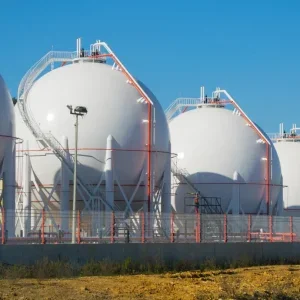When building new dams, greater attention is now being paid to construction schedules and budgets, especially in developing countries. From an economical point of view, early impoundment offers great benefits. Using seasonal characteristics and forecasting models, the first filling of reservoirs can be achieved after the flood season but the spillway should be in service before the next flood season. In the course of researching the early impoundment of the 165m high Marun dam in Iran, a strategy based on a doctoral dissertation entitled ‘holistic design of adaptive hydraulic structures’ was adopted. The main principles of holistic design are to:
• Ensure a flexible and adaptive design in view of hydro systems changes and the inherent uncertainties of water engineering.
• Establish the interdependence of hardware (structures) and software (management and knowledge) in design.
• Adapt to the stochastic nature of river flow by integration of seasonal characteristics and river forecasting.
• Design hydraulic structures to adapt to extreme events far larger than design parameters and remain inherently safe (ductile failure).
• Base the design on comprehensive management and flexibility.
• Enhance safety by ‘designing’ crisis management preceding the events and in real time for the structure and downstream population centers.
• Monitor hydro system and structures on a continuous basis.
The Committee of Costs of icold presented a paper in Beijing in 2000 entitled Non-structural risk reduction measures: Benefits and costs for Dams, which emphasises the capabilities and cost-effectiveness of non-structural measures for reducing the risk of dams. The Committee is currently preparing a bulletin on the subject. The conclusions of the paper are quite similar to those of the holistic design. The main difference is that the Committee of Cost has focused on the application of non-structural risk reduction measures in constructed dams while holistic design calls for the integration of structural and non- structural measures in design in addition to the operation.
With early impoundment of reservoirs, the integration of these strategies would not only make it possible to fill the reservoir safely, even with an incomplete spillway in the next flood season, but also to minimise delay in construction activities. To achieve flexibility when first filling the reservoir, the rapid unplugging of the diversion tunnel should be feasible any time after the filling. This can guarantee the safety of the dam if the spillway is not in service in the next flood season, or if any unforeseen problem occurs. Conventional long concrete plugs lack the desired flexibility, and explosion by drilling would not be feasible due to hydrostatic pressure on the plug at the last stage of blasting. As a result of structural superiority of shells, however, a thin concrete shell can be utilised for plugging diversion tunnels. The blasting holes can be arranged during construction and the shell, appropriately called a fuse shell, can readily be exploded if required.
A fuse shell would enhance flexibility and ductility of probable failure modes, but during implementation, crisis management, monitoring and forecasting are required. By embedding a steel shell in the fuse shell, slow drawdown would be possible by explosion of the steel shell. When required, rapid drawdown can be achieved by exploding the fuse shell completely. In view of the Marun dam project, the experience of first filling demonstrates the advantages of the fuse shell.
The importance of the Marun project for the economy of the region has turned it to a principal project among the development programmes in Iran. The main objectives of this project are to regulate the Marun river and provide a dependable water resource for irrigation in the four plains of Behbahan, Jayezan, Khalafabad and Shadegan. With the completion of this project at least 50,000 ha of land will be irrigated.
The Marun dam is situated approximately 19km north of Behbahan in Khozestan province. Located on Marun river, the 165m high rockfill dam is the second highest embankment dam in Iran and has a crest length of 340m. The reservoir volume is 1200Mm3 and the dam volume is 12Mm3. Main features of the dam include a gated-chute spillway on the right abutment with a maximum design discharge of 10800 m3/sec. A 150MW power plant utilises the released water through a pressurised tunnel to generate electricity. There are six tunnels in the left abutment, and 14 grouting and access galleries in different elevations, with a total length of 2700m.
Construction of the diversion system was initiated in 1989. The original diversion system consisted of an 11m diameter and 494m long concrete lined tunnel on the left bank together with a 40m high cofferdam, which was completed in 1992. A few months later, in Feb-ruary 1993, a moderate flood overtopped the cofferdam which was breached three hours after the initiation of the overtopping. It was concluded that the design flood was underestimated. A 20-year flood with a peak flow of 2500m3/sec was used for the design flood of the diversion system. The flood was calculated with 26 years of data in 1983. Large floods actually occurred in 1986, 1989 and 1991. In December 1992, just before the overtopping of the cofferdam, the hydrological study was updated (with considerable delay) and the 20-year flood was increased to 3100m3/sec.
Unfortunately, the diversion system could actually pass only 10-year floods and failed in the moderate flood of February 1993. This suggests that the updating of hydrological studies should have been concluded earlier. It also demonstrates the importance of monitoring and continuous design of hydraulic structures, which are among the main principles of holistic design.
Since 1980, roller compacted concrete (RCC) has been used to hydraulically upgrade more than 70 existing embankment dams (to provide for overtopping), a method which has proven both effective and economical.
If Marun cofferdam had been protected by an RCC overlay, it would have overtopped safely in February 1993. Even the unprotected cofferdam resisted overtopping for about three hours before the final breaching. But at that time the consultants decided to enhance the safety against overtopping by constructing another diversion tunnel. Consequently diversion tunnel two (DT2), with a diameter of 13m and 683m in length, was constructed in two months in summer of 1993. The tunnel is unlined. At the intersections of the tunnel with middle Asmari rocks, due to Marl layers, the rock is heavily jointed and there are several weak zones. As a result, shotcrete was required during excavation of the tunnel. Although RQD is rather high in these zones, the lithology of the rocks has produced weak zones.
The dam site is on the upstream limb of an Asmari limestone anticline. Here, the limestone is reasonably hard, with beds sloping about 34? upstream. The thickness of the limestone beds varies from about 2m in the middle Asmari to greater than 5m in the lower and upper Asmari. Some thin interbeds of shale are present in the middle Asmari. Several joint patterns exist, with the major joint system parallel to the river at the axis of the dam. Excavation for the rockfill dam was not excessive, mainly the removal of talus under the shell, and 5-10m of trimming under the core. All structural elements were designed for moderate to heavy earthquakes. The design of the grouting curtain was not modified to account for the construction of DT2 and this to a large extent caused the excessive leakage after the first filling.
FIRST IMPOUNDMENT
In 1995, it was decided to impound the reservoir in the summer of 1996 for agricultural purposes. The initial scheme, proposed for the impoundment by consultants, was based on rapid construction of the embankment to an elevation above the excavated spillway by January 1996. The scheme proved to be unrealistic because, even by January 1997, the embankment had not reached the proposed elevation. As a result, an impoundment scheme based on ‘holistic design’ strategies was proposed.
Hydrological studies indicated that the largest floods of Marun river occur in January and February. The flood potential decreases substantially in April and May. Frequency analysis indicated that in dry years there is practically no excess water for storage in the reservoir in February. As a result, this month was selected as the earliest possible time for impoundment.
By the end of February, approximately 50% of annual precipitation is observed in the Marun basin. Consequently river forecasting appeared to be beneficial. A forecasting model based on a MLP artificial neural network (ANN) was developed and it was discovered the forecasted discharges corresponded closely with observed flows. In real time, forecasted flows were updated regularly and the performance of the model was satisfactory in 1996-1999. Utilising river forecasting and seasonal flood characteristics, an optimum time could be selected for safe impoundment of the reservoir.
After monitoring the progress of the embankment construction in early 1996, it was concluded that the elevation of the embankment would be lower than the spillway crest in the flood season of 1997. The only way to ensure safety was to plug the tunnel with a fuse shell.
Temporary impoundment
With a fuse shell, temporary impoundment became possible to satisfy the agricultural demand and minimise delay in construction activities at the same time. The structural analysis of the fuse shell demonstrated that stresses and strains in a thin concrete shell under hydrostatic pressure are well below allowable stresses.
In late February 1996, the forecasting model indicated that river flow in the following summer could satisfy the agricultural demands. Subsequent forecasts confirmed the initial results of the artificial neural network model, leading the owner to abandon the impoundment scheme. The observed flows corresponded closely with the forecasted ones and no water shortages were encountered.
By March 1997, the embankment had been constructed to 80% of its final height. Nevertheless, the gates of the bottom outlet and pressure tunnel had not been installed. Accordingly, the maximum storage of the reservoir was 70Mm3 and the forecasting model indicated that filling of the reservoir should begin in early June. Unfortunately the forecasting was not heeded and impoundment of Marun reservoir started on 15 March. Since it was believed that the spillway would be in service by the next flood season, the implementation of the fuse shell was abandoned. Instead, a long concrete plug was constructed 200m from the entrance in DT2. Stoplogs were used for closing DT1.
Immediately after the impoundment however, considerable leakage was observed in the pressure tunnel which was traced to DT2. At this stage, the efforts to open the stoplogs failed. At the same time, an embankment was constructed in front of the DT2, and subsequently grouting controlled the leakage in the pressure tunnel. With increasing water elevation in the reservoir, the embankment in front of DT2 was overtopped and considerable leakage of up to 7m3/sec initiated from weak zones upstream of the plug in DT2.
The major flow, approximately 4.5m3/sec, was from two large solution channels and leakage around the concrete plug. The remaining flow was from the access tunnel and the grouting adit LG3 (2.3m3/sec). Drain holes in the dam body at the toe were dry. The rock strata at the site comprises a series of karstic limestones interbedded with water sensitive Marls which dip towards the reservoir. In addition there are two major joint sets, the first parallel to the bedding and dipping in the opposite direction, and the second crossing the bedding. The water entered the fissure system upstream of the plug in DT2 and passed along the fissures, forming large cavities and it washed out the marl. Water was leaking into all tunnels between DT2 and the dam, and entry into some tunnels was not possible due to high water flows. It was reported that all springs received their waters from the same fissure.
Controlling leakage
The erosion connected DT2 to an access gallery close to the embankment. The efforts to control the leakage by grouting failed due to excessive flows. Even chemical grouting appeared to be ineffective in blocking the flow. At the early stage of the crisis, a number of experts visited the site and there were serious concerns about the possibility of the thin shotcrete cover (10mm at some locations) breaking at core-rock contact, resulting in erosion of the core. The consensus among the experts was to draw down the reservoir immediately. At the beginning of the crisis, the forecasting indicated that the reservoir would not be drawn down during summer. The 1.4m pipe embedded in the plug lacked the required discharge capacity. There were some speculations, however, that the reservoir would be drawn down during summer. Eventually the forecasting model proved to be accurate.
The proposal for reopening the plug of DT2 was found to be unfeasible. By the end the summer, the consensus was that the complete draw down of the reservoir by the embedded pipe in DT2 would be achieved only by early November 1997 (as correctly forecasted by the ANN model six months earlier). Schemes for controlled explosion of one gate of DT1 were prepared and a number of tests were performed at the site.
The controlled explosion was a success and the crisis ended in September 1997, six months after the impoundment. The reservoir draw down was achieved in six days.
During the spring and summer of 1997, Marun reservoir appeared to be an ideal habitat and fish population expanded rapidly. Unfortunately, a large number of fish died after the explosion of the gates due to the turbidity of the water, and excessive velocity of the flow in the tunnel.
To ensure water tightness of the reservoir, the grouting curtain was extended (a considerable quantity of cement was grouted to 300,000 grouthole meters) and some parts of DT2 were lined in 1997-1999. The final impoundment started in May 1999 and the water tightness of the reservoir has been satisfactory with a maximum water head of 85m.
LEARNING FROM EXPERIENCE
The leakage crisis experienced at Marun dam demonstrated the importance of flexibility and forecasting in design. Utilisation of a fuse shell could have ended the crisis in two or three days instead of six months. The proposed thin concrete shell could have been readily exploded in the early stage of the crisis as the blasting holes had been arranged during construction and a detailed scheme had been planned before the impoundment. It was also learned that a fuse shell can make temporary impoundment feasible and the water tightness of the reservoir can be investigated before final impoundment. This can result in a more efficient design of grouting curtains.
Worldwide experience clearly indicates that the last year of construction and the first years of operation is the most dangerous period for dams even in regards to overtopping which seems to have nearly equal probability during operation. As a result of experiences at Marun reservoir in 1997, there is a scheme for implementing fuse shells in other Iranian dams to investigate structural considerations and the practical problems of constructing and exploding the shells.
Masjed Solayman dam
The first practical application of the fuse shell was in another Iranian dam, Masjed Solayman on the Karun river. In fact, there are striking similarities between the this and Marun dam. Both are high rockfill dams — with heights of 178 and 165m they are the highest and second highest rockfill dams in the country — and there are two diversion tunnels in each project. Due to the small volume of the reservoir of Masjed Solayman (228Mm3) compared to the volume of the Karun river (about 11500Mm3 at the dam site), the Japanese financiers insisted on using a fuse element in the plugging of one of the diversion tunnels.
The fuse was planned for probable controlling of the water level during the first impoundment. At the first stage of the design, a steel cylindrical shell 4m in diameter was considered as the fuse element. However, it was later decided to use concrete. Structurally the U-shaped plug is designed to demonstrate an arch action. The explosion holes were arranged during the construction of the plug using PVC pipes. Due to the short length of the plug, water tightness was a concern. Another important consideration was the opening of the stop logs at the beginning of the diversion tunnel in emergencies. As the stop logs were designed with an assumption of equal hydrostatic pressures on both sides, the explosion of the plug would trigger the failure of the stop logs and opening of the diversion tunnel.
Unlike the Marun project, there was no need for explosion of the plug in the first impoundment of the Masjed Solayman dam in December 2000. However, the existence of the fuse shell gave the owner and consultants the assurance required for a safe and flexible impounding scheme.
Related Articles
Spotlight on…RCC
Tables
Tunnels in the left abutment of Marun dam…






